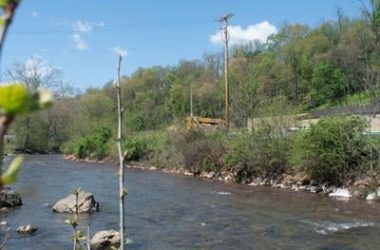BUCKHANNON, W.Va. — Hundreds of people studied the maps and diagrams of the proposed Atlantic Coast Pipeline that lined the walls and tabletops Wednesday at the Virginia Thomas Law Center for the Performing Arts at West Virginia Wesleyan College.
Dressed in brown polo shirts adorned with stickers that read “ACP Yes!,” project team members were on hand to answer questions and provide information about the proposed 550-mile, $1 billion pipeline that would carry natural gas from Harrison County down into Virginia and North Carolina.
Many of the team members were from Dominion, the company that proposes to build the gas-transmission line. The company held a four-hour open house to provide the public with information about the project.
While some people felt the information was helpful, others felt the company wasn’t saying any more than it already has about the project.
The pipeline would start in Harrison County and continue into Lewis, Upshur, Randolph and Pocahontas counties. It would bisect Virginia and the eastern part of North Carolina.
The pipeline is currently in the survey and route planning stages; the company is preparing to prefile with the Federal Energy Regulatory Commission, which will have to approve the project.
Dominion doesn’t plan to file the application to the FERC until summer of 2015 and wouldn’t expect to receive a certificate until the summer of 2016.
Construction would take place in 2017 and 2018, with the pipeline going into service in late 2018, according to Dominion.
Betsy Miles lives in Lewis County and owns property located in the pipeline study corridor. She appreciated the maps and the diagrams, saying they were helpful in giving her a visual idea of the proposed route.
“I think it was adequate for showing where the pipeline is going and how it’s going to affect certain people in the area, but as far as in-depth information, everything they have here they’ve already presented in the newspapers,” Miles said.
Nancy Bevins of Buckhannon was under the impression the open house was going to be more of a town-hall style meeting, where the company would make a presentation and then conduct a question and answer session, as well as allow public comment.
Another gas company held a community outreach several months ago and was “pummeled” by the audience, she said.
“That’s probably why they did it this way instead of opening it up to a question and answer session,” Bevins said.
Bob Fulton works in corporate communications for Dominion. He said town-hall meetings will come later. The company wants to meet with the public using a number of different formats. But because the proposed route for the pipeline is in the early stages, the company felt it was best to provide landowners and any other interested parties a chance to talk with company officials one-on-one.
Miles hasn’t made up her mind about the pipeline. No one from Dominion has met with her in-person about an agreement involving her land, she said. A lot more information needs to be made public before people can make informed decisions, she said.
“You have to look at the whole picture. You have to realize that you’re dealing with a multi-billion dollar corporation versus landowners versus environmentalists. There’s a lot of information that I feel needs to be forthcoming before any of this could really be effective,” she said.
So far, Dominion’s initial contact with Miles has been less than thrilling. She said a survey crew contacted her about coming out to her property, but didn’t follow through with some specific requests she made.
“We were disappointed. We had asked them that before they came on the property to call us. We provided them with adequate phone numbers. And of course, they didn’t call. We have found flags on the property. They didn’t follow through with what we asked them to do,” she said.
Bevins said she understands that people need jobs and the oil and gas industry provides them, but she also worries about preserving the natural beauty of West Virginia.
“It’s just such a mess. People need to make a living. I moved to West Virginia 17 years ago from Los Angeles. For me, West Virginia is a place to get away from everything. People come here to get away from industrialization, large cities, pollution and everything else,” she said.
It isn’t likely that anyone will be able to stop the pipeline from being constructed, Bevins said. The U.S. economy is too dependent on oil and gas. She does, however, feel that there needs to be more regulation, as well as more research into renewable energy sources.
“West Virginia has been a state that has given and given and has been taken from. And for what? We’re still one of the poorest states in the nation and we’re still willing to give it away. That’s what people aren’t realizing. What’s in it for West Virginia other than a few dollars and a few temporary jobs?” she said.
Dud Filbey of Rock Cave has a much different perspective. He has a gas well on his land, and he’s had both good and bad experiences with gas companies.
Filbey also has worked in the pipeline business. He believes Dominion will be a good steward with the Atlantic Coast Pipeline.
“This is going to happen regardless of how people feel. As long as the thing is done under environmental control and safety measures, I have no problem with it,” he said. “Every day, everything expands and changes because of technology. You’ve got to learn to accept the facts and deal with it.”
Others aren’t so sure that much of what is presented as fact is actually the truth.
Jim Sconyers is the chair of the West Virginia Sierra Club. He and others attended the open house to pass out flyers in protest of the pipeline.
There is just too much about the pipeline that will mean bad news for West Virginia, Sconyers said.
First, the proposed route crosses several waterways and cuts through the Monongahela National Forest.
“(That) is an insult to the best jewel of the wild lands of West Virginia,” he said. “They’re also doing the same thing in Virginia to the George Washington National Forest.”
But that isn’t the Sierra Club’s sole concern. Sconyers said a large pipeline similar to the proposed Atlantic Coast Pipeline was built in Nebraska. Like the West Virginia portion of the Atlantic Coast Pipeline, it was 42 inches in diameter. He pointed to a photo on a protest flyer that depicted a large swath of displaced earth in the plains of Nebraska.
“You can see the scale of destruction involved in building a pipeline like this on level ground out in the Great Plains. They’re talking about putting something like that up and down 4,000-foot mountains,” he said. “They’ve never built anything like this before, this scale, this size through this kind of terrain. The potential fragmentation of wildlife habitat is beyond belief.”
Sconyers also has a major concern about a lateral extension of the pipeline near the Virginia-North Carolina border that goes straight toward the East Coast and the Atlantic Ocean.
“Is this for American energy independence, which is how it’s sold to us? Then why do they have a big spur going off to one of the major American ports on the East Coast? So they can ship to Charleston, S.C.? I don’t think so,” he said.
When asked Tuesday, Fulton said the gas transmitted through the line would not be for export purposes.
Fulton said Tuesday’s open house was a success. Many people had numerous questions about the pipeline, and officials did their best to answer all of them.
“There’s been a very productive dialogue about what the pipeline might look like. All in all, it’s been very beneficial,” he said.
Rob Hinton is the executive director of the Upshur County Economic Development Authority. He spoke at length to numerous company representatives at the open house.
Hinton believes the pipeline has the potential to make a huge economic impact for the oil and gas industry in West Virginia, and he appreciated Dominion’s efforts in providing information to the public.
“I thought the information today was good. It was a good start for them to introduce the pipeline and for them to give residents an understanding of what’s coming down the road,” he said.




